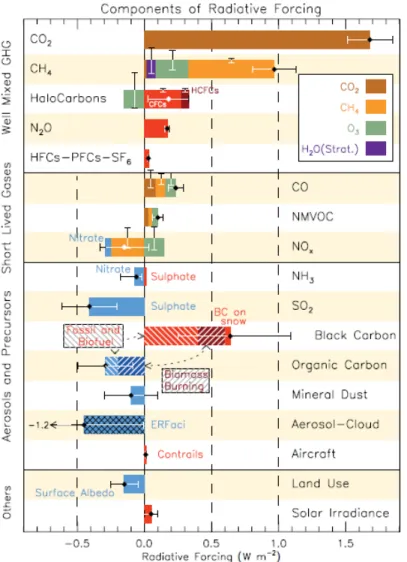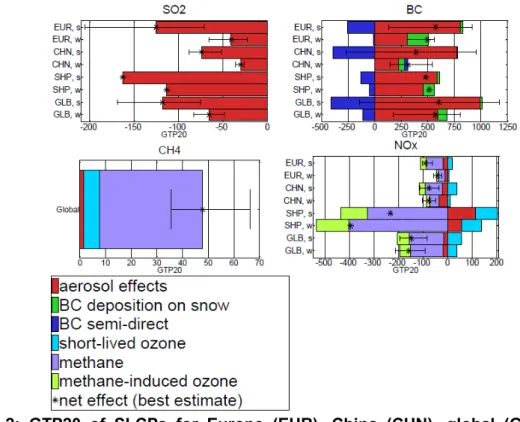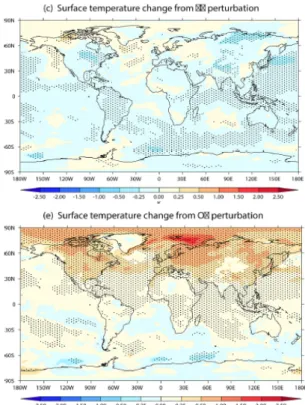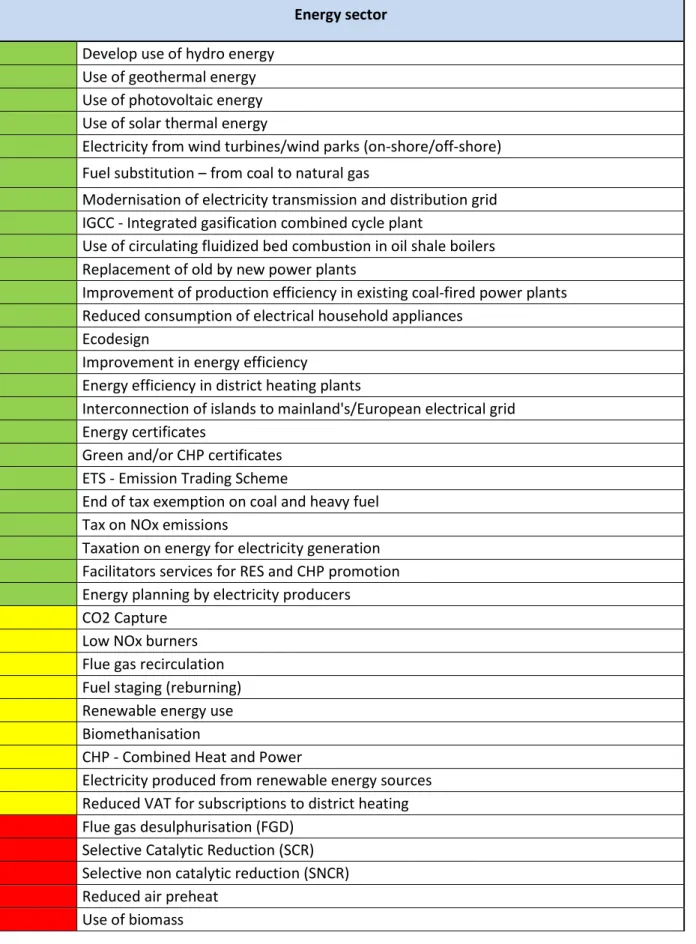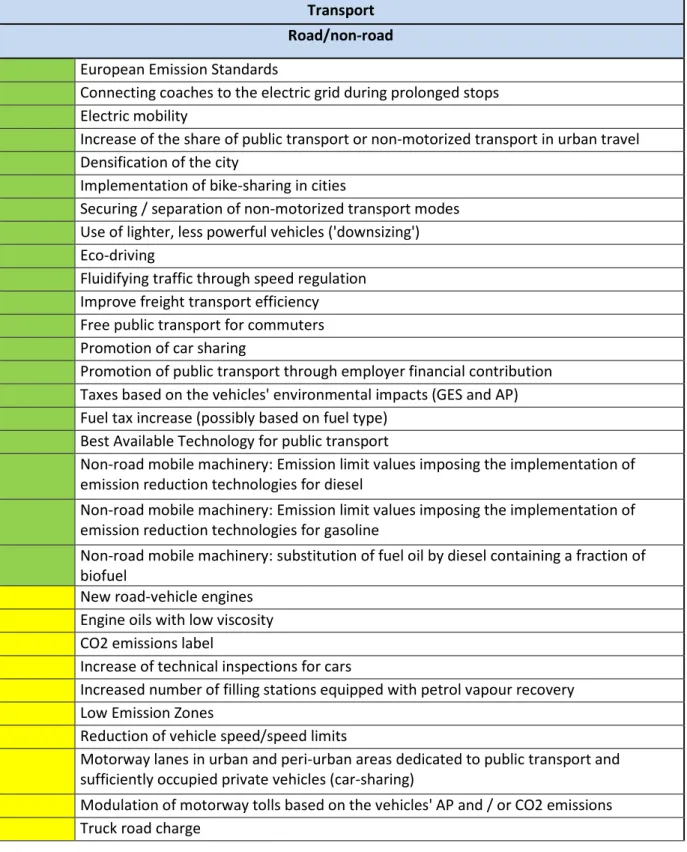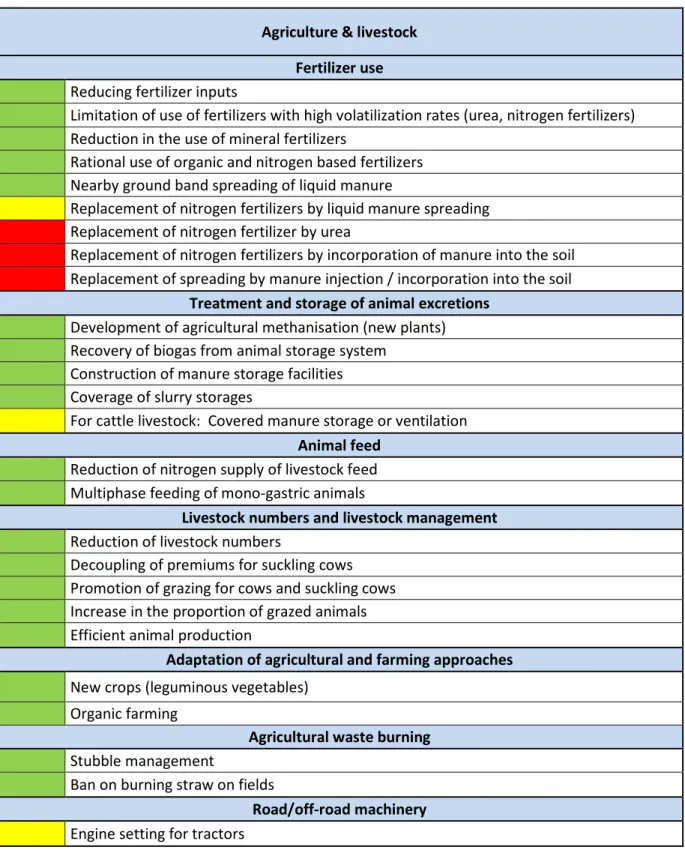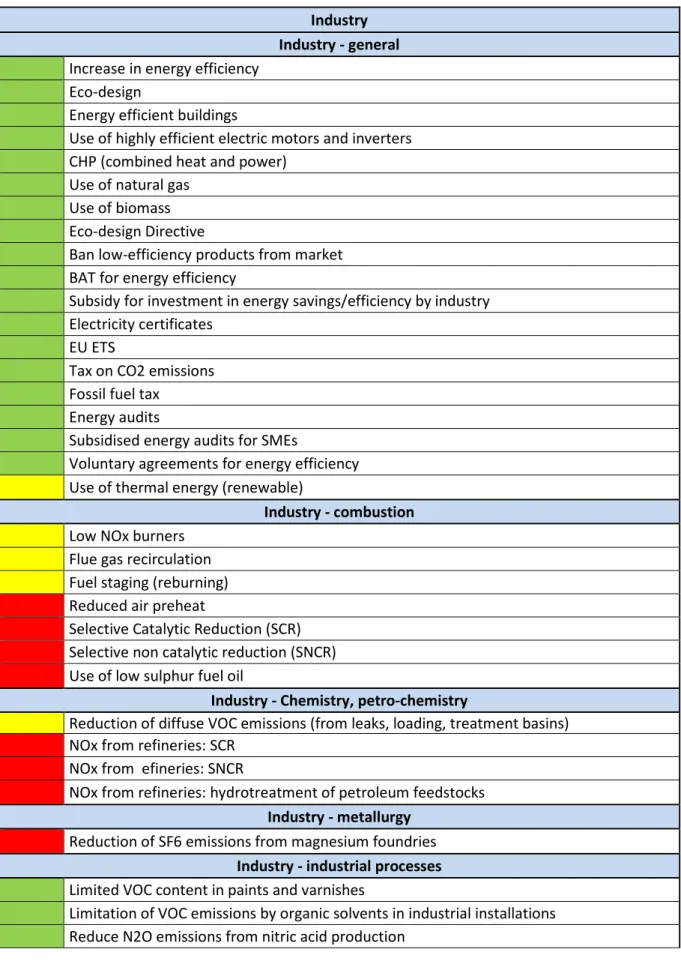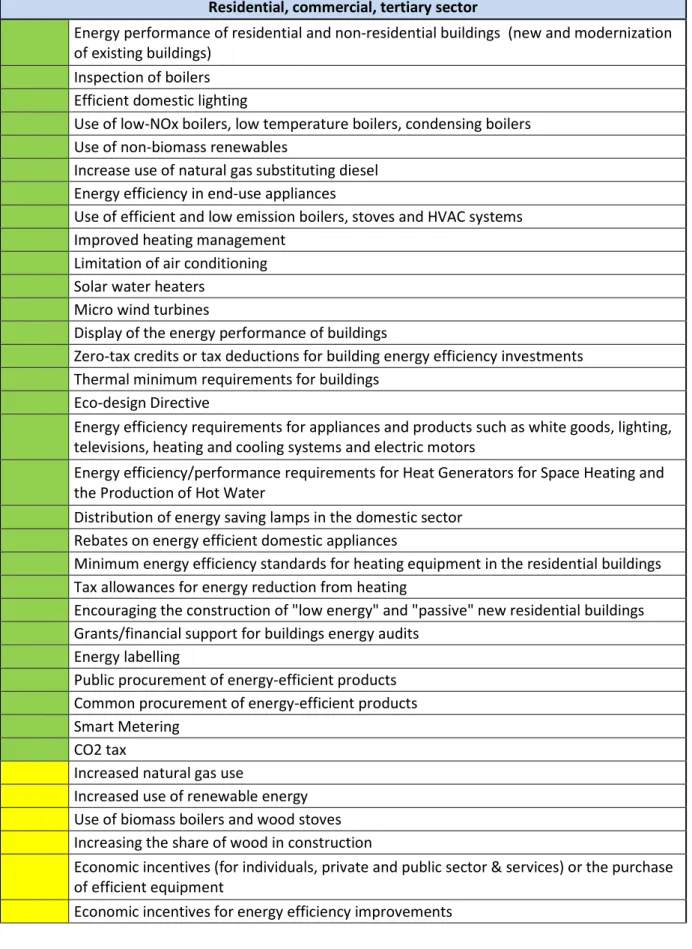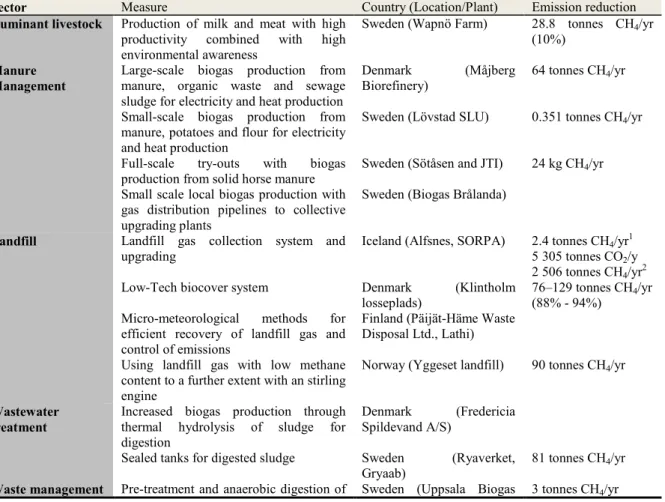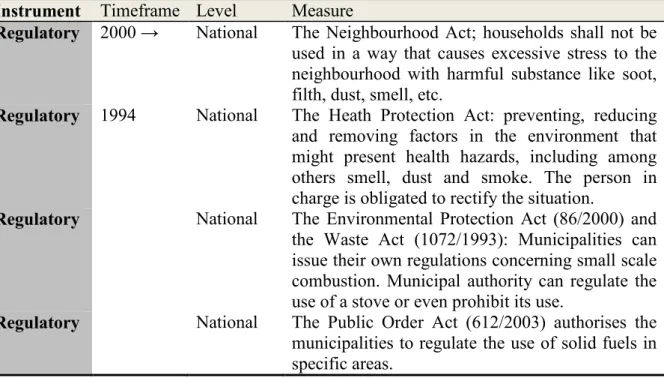Joint Actions for Air Quality and Climate Mitigation
in Europe
ETC/ACM Technical Paper 2015/7
December 2015
Augustin Colette, Elsa Réal, Simone Schucht,
Susana López-Aparicio, Hans Eerens, Kees Peek,
Paul Ruyssenaars, Cristina Guerreiro
The European Topic Centre on Air Pollution and Climate Change Mitigation (ETC/ACM) is a consortium of European institutes under contract of the European Environment Agency RIVM Aether CHMI CSIC EMISIA INERIS NILU ÖKO-Institut ÖKO-Recherche PBL UAB UBA-V VITO 4Sfera
Front page picture:
IPCC Fifth Assessment Report: Radiative forcing bar-chart comparing the climate impact of various forcers over the period 1750-2011 (Myhre et al., 2013b).
Author affiliation:
Augustin Colette, Elsa Réal, Simone Schucht, INERIS, Institut National de l’Environnement Industriel et des Risques, France Susana López-Aparicio and Cristina Guerreiro, NILU –Institute for Air Research, Norway
Kees Peek, Paul Ruyssenaars: RIVM, The Netherlands Hans Eerens: PBL, The Netherlands
DISCLAIMER
© ETC/ACM, 2015.
ETC/ACM Technical Paper 2015/7
European Topic Centre on Air Pollution and Climate Change Mitigation PO Box 1 3720 BA Bilthoven The Netherlands Phone +31 30 2748562 Fax +31 30 2744433 Email etcacm@rivm.nl Website http://acm.eionet.europa.eu/
This ETC/ACM Technical Paper has not been subjected to European Environment Agency (EEA) member country review. It does not represent the formal views of the EEA.
Contents
Abstract ... 7 1 Introduction ... 8 2 Background Information on SLCPs ... 9 2.1 Definitions ... 9 2.1.1 Methane ... 9 2.1.2 Tropospheric Ozone ... 9 2.1.3 Nitrogen oxides ... 92.1.4 Carbonaceous and organic aerosols ... 10
2.1.5 Inorganic aerosols ... 10
2.1.6 HydroFluoroCarbons ... 10
2.2 Climate Impacts ... 11
2.3 Inventories ... 14
2.4 International Policy Instruments and Initiatives ... 15
2.4.1 Global Conventions and Protocols ... 15
2.4.2 Regional Convention and Protocols ... 15
2.4.3 International Cooperative Initiatives ... 16
3 Air Quality and Climate Mitigation Measures ... 18
4 Case Study on SLCP Action Plans in Nordic Countries ... 26
4.1 Introduction ... 26
4.2 Science and Policy Background ... 26
4.3 Denmark ... 29
4.4 Finland ... 30
4.5 Iceland ... 31
4.6 Norway ... 32
4.7 Sweden ... 36
5 Case study on air quality and climate cobenefits in the Netherlands ... 39
6 Overview of integration air quality and climate action plans in other European countries ... 41
6.1 Methodology for the overview of SLCP Action Plans ... 41
6.2 Austria ... 42
6.3 Belgium ... 42
6.4 Bulgaria ... 42
6.5 Cyprus ... 43
6.7 Estonia ... 43 6.8 France ... 43 6.9 Germany ... 44 6.10 Greece ... 44 6.11 Hungary ... 44 6.12 Ireland ... 44 6.13 Italy ... 45 6.14 Latvia ... 45 6.15 Lithuania ... 45 6.16 Luxemburg ... 45 6.17 Malta ... 45 6.18 Poland ... 45 6.19 Portugal ... 46 6.20 Romania ... 46 6.21 Slovakia ... 46 6.22 Slovenia ... 46 6.23 Spain ... 46 6.24 Switzerland ... 46 6.25 United Kingdom ... 47 7 Synthesis ... 48 7.1 Overview ... 48 7.2 Quantitative Analysis ... 51
7.2.1 Identification of GHG/AQ Interactions in European countries ... 51
7.2.2 SLCF mitigation (CH4 and HFC) ... 52
8 Annex 1: Web Survey on National SLCP Plans ... 55
9 Annex 2: List of measures with identified trade-off or benefit for air quality and climate mitigation ... 57
9.1 Energy sector ... 59 9.2 Transport ... 73 9.2.1 Transport: Road/non-road ... 73 9.2.2 Transport: Aviation ... 87 9.2.3 Transport: Rail ... 88 9.2.4 Transport: Shipping ... 90
9.2.5 Transport: Non determined mode ... 92
9.3 Residential, commercial, tertiary sectors ... 93
9.4 Industry ... 104
9.4.1 Industry: general ... 104
9.4.2 Industry: combustion ... 108 4 ETC/ACM Technical Paper 2015/7
9.4.3 Industry: chemistry, petro-chemistry... 110
9.4.4 Industry: metallurgy ... 111
9.4.5 Industry: industrial processes ... 111
9.5 Agriculture and livestock ... 113
9.5.1 Agriculture and livestock: Fertilizer Use ... 113
9.5.2 Agriculture and livestock: Treatment and storage of animal excretions ... 115
9.5.3 Agriculture and livestock: Animal feed... 116
9.5.4 Agriculture and livestock: Livestock numbers and livestock management ... 117
9.5.5 Agriculture and livestock: Adaptation of agricultural and farming approaches ... 118
9.5.6 Agriculture and livestock: Agricultural waste burning ... 119
9.5.7 Agriculture and livestock: Agricultural machinery ... 119
9.6 Waste treatment ... 120
10 References ... 123
Abstract
Air quality improvement and climate change mitigation constitute two of the most pressing environmental challenges. Even if the atmospheric compounds concerned differ (air pollutants versus greenhouse gases), they are in the majority of cases emitted by the same sources. There is thus scope to join efforts and benefit from mutual leverage in triggering action.
Combined action for air and climate can be undertaken by (i) targeting atmospheric compounds that happen to have detrimental impacts on health, ecosystem and climate at the same time, (ii) targeting emission sources that emit a cocktail of pollutants and greenhouse gases.
Under item (i), we find the theme of Short-Lived-Climate-Pollutant mitigation. Several atmospheric constituents can be considered as both climate forcer and pollutants. It is chiefly the case of black carbon and methane. There is a growing concern that a putting the priority on such species could mutualise benefits for air and climate.
Under item (ii), considering that the vast majority of anthropogenic activities would emit at the same time pollutants and greenhouse gases, we find a long list of measures that can yield cobenefits (synergies) or trade-off for air and climate.
The present document aims at assessing the level of awareness in Europe about joint actions to improve air quality and mitigate climate change. Background information on SLCP is provided, as well as a detailed list of measures offering cobenefits or trade-off for air quality and climate mitigation. An analysis of the situation in European countries is also performed together with selected case studies for Nordic countries.
We conclude that there is a solid body of evidence for opportunities for joint action on air quality and climate change (either through SLCP mitigation or acting on synergetic sources). There are a number of international activities to foster action on SLCP, but at present only Norway has developed a concrete national action plan. The level of awareness on synergies is higher and it should be noted that most countries have identified potential synergies for air quality in their greenhouse gas mitigation plans.
1 Introduction
Black carbon, methane, tropospheric ozone (O3) and hydrofluorocarbons (HFCs) are
responsible for 40-45% of the historical anthropogenic radiative forcing (Forster et al., 2007). These chemical species have lifetimes from hours to about 15 years in the atmosphere and are therefore referred to as short-lived climate forcers (SLCFs). Contrary to carbon dioxide (CO2), reducing SLCFs emissions may prevent as much as 90% of their predicted warming
effect within decades, the final 10% would be delayed for hundreds of years due to thermal inertia of the climate system (Zaelke and Borgford-Parnell, 2013).
In order to emphasise their detrimental impact on human health and ecosystems, the term Short Lived Climate Pollutants is also found in the literature (SLCPs). Black carbon, as any other aerosols contributing to particulate matter, have detrimental impacts on human health, in particular cardiovascular mortality and cardiopulmonary hospital admissions (WHO, 2013). Short term exposure to ozone pollution has also adverse impacts on health (WHO, 2013), and ozone is detrimental for crops and ecosystems too (Simpson et al., 2014). Methane is also considered as a SLCP, rather for its role as precursor of tropospheric ozone than for direct impact on human health and ecosystems. HFCs were introduced in industrial processes to replace chlorofluorocarbons (CFCs) banned after the Montreal Protocol because of their adverse impact on the stratospheric ozone layer, and therefore on human health through UV radiation. On the contrary to CFCs, HFCs have no impact on stratospheric ozone and cannot be considered as pollutants or precursors, they are however considered as SLCF because of their short lifetime and strong warming potential.
Reducing emission of SLCPs would lead to benefits in terms of both climate mitigation and air quality. In addition, it is expected that such benefits would be felt on the short term. SLCP mitigation became therefore quite legitimaly a topic of science and policy discussions since the publication of a joint report by UNEP (United Nations Environment Programme) and WMO (World Meteorological Organisation) on the topic in 2011 (UNEP and WMO, 2011) and the subsequent launch in 2012 of the Climate and Clean Air Coalition (see later section on International Initiatives, Section 2.4.3). An additional interest was raised by Countries of the Arctic Council because global warming is particularly fast at high latitudes. The threat of an irreversible melting of the Arctic fosters the need for fast action at these latitudes.
It should be noted that, besides SLCPs, there are also vast opportunities to reduce simultaneously greenhouse gases and air pollutant emissions (e.g. the cobenefits of improving energy efficiency), such measures will also be discussed in the present report. After a decade of discussion in the science community, and 3-5 years in policy forums, it is now timely to propose an overview of the level of awareness on joint air and climate action in Europe. It is the aim of the present report that includes: general background information on SLCPs in Section 2 (definition, impacts, inventories, existing policy instruments as well as a compilation of existing mitigation measures that can affect air quality and climate change at the same time), a list of mitigation measures offering synergies or trade-off for joint action on air quality and climate mitigation beyond specific SLCP actions (Section 3), two detailed case studies on Nordic Countries (Section4) and the Netherlands (Section 5), and a general overview of overlaps between air and climate action plans in all other European countries (6).
2 Background Information on SLCPs
The main atmospheric chemical compounds of interest in relation with short term air quality and climate change interactions are methane and black carbon because of the clear cobenefits of reducing their emissions for climate change as well as human health and direct impacts on ecosystem and crops. Although less often pointed out, HFCs, Ozone, NOx (nitrogen oxides), NMVOCs (non-methane volatile organic compounds), organic aerosol (OA) as well as sulphate and nitrate secondary inorganic aerosol are also sometimes mentioned in this context. The present section includes a few definitions and background information on their impact on air quality and climate change. We also propose here an overview where SLCP are dealt with in existing international agreements and initiatives.
2.1 Definitions
2.1.1 Methane
Methane (CH4) is a strong greenhouse gas and a precursor of ozone. About 60% of methane
emissions at the global scale come from anthropogenic activities (CCAC, 2014). In North America and Europe the main activity sectors responsible for CH4 emissions are fossil fuel
extraction and distribution, waste/landfill, and agriculture, in approximately equal proportions (UNEP, 2011).
The absolute global warming potential of methane per unit mass emitted is 28 times larger than that of CO2 but it’s lifetime is much shorter, with 12.4 years (Myhre et al., 2013b). In
2000, Europe was responsible for about 15% of global anthropogenic emissions according to the Representative Concentration Pathways of IPCC (HTAP, 2010). CH4 has no direct impact
on health and ecosystem but it is a very important ozone precursor, to such extent that it was found to have a similar impact on ozone change since the 1960s in Europe than all other local or global precursors (Wild et al., 2012).
2.1.2 Tropospheric Ozone
Ozone is an atmospheric oxidant not emitted directly by human activities, but formed in the atmosphere because of emissions of NOx, NMVOCs, CH4, and CO. It is responsible for
25,000 premature death per year in Europe (IIASA, 2013) as well as substantial negative impacts on crops yields. It has a radiative forcing of about 15% that of well mixed greenhouse gases (Myhre et al., 2013b).
2.1.3 Nitrogen oxides
In the context of air quality and climate interactions, nitrogen oxides are only relevant because of their role of precursors of ozone and aerosols, as well as their impact on methane. NOx contribute to the (i) formation of tropospheric ozone and (ii) ammonium nitrate aerosol, but they tend to (iii) decrease CH4 lifetime, henceforth concentrations. Because tropospheric
ozone and CH4 are warming agent, and ammonium nitrate is mainly cooling, reducing NOx
emission would have a cooling effect because of (i), but a warming effect because of (ii) and (iii).
2.1.4 Carbonaceous and organic aerosols
Black Carbon is a type of aerosol singled out for its property to interact with light (hence the reference as black) and therefore its importance in the climate context.
Black carbon is emitted as a result of incomplete combustion. In Europe about half of BC emissions are due to traffic sources, followed by heating and agricultural burning totalling about 10% of global emissions (Bond et al., 2013). Carbonaceous aerosols were historically referred to as soot, today the terms “black” or “elemental” carbon (BC or EC) are found. Both of them are based on an idealized view of carbonaceous aerosols that would be ideally absorbing light (as a black body for BC), or considered as an atom of carbon not bounded to any other chemical element (EC)(Petzold et al., 2013).
Black carbon is generally co-emitted with a fraction of primary organic carbon or NMVOCs that can ultimately lead to the formation of secondary organic carbon. This co-emission challenges the identification of mitigation measures that would be unequivocally leading to warming reductions (Unger et al., 2010), looking for high BC/OA ratios (Stohl et al., 2015). Whereas black carbon contributes to warming through absorption of sunlight and reducing the surface albedo when deposited on snow, organic aerosols tend to scatter light and therefore have a cooling effect. Both type of carbonaceous aerosol (and any other aerosol) have an indirect impact on climate through the formation of clouds which, although still uncertain, likely also contribute to a cooling effect (Boucher et al., 2013).
2.1.5 Inorganic aerosols
Ammonium nitrate and sulphate aerosols fall in the category of secondary inorganic aerosols. They are formed in the atmosphere as a result of emissions of sulphur dioxide and ammonia in the presence of nitrogen oxides and contribute to the mix referred to as “particulate matter” (PM). Sulphate aerosol are very efficient at scattering light, and exert as such a cooling effect on climate. Nitrate is also mainly cooling the climate, but to a lesser extent. Similarly to BC, they also have an indirect cooling impact on climate through perturbation on clouds.
2.1.6 HydroFluoroCarbons
HFCs is a family of compounds with an atmospheric lifetime of days to several decades, and a global warming potential (GWP100) reaching the thousands, making them very important short-lived climate forcers. They don’t have any impact on air quality and can therefore not be considered as pollutants. They were introduced as a substitute for ozone depleting substances (such as chlorofluorocarbons – CFCs – and hydrochlorofluorocarbons – HCFCs) and the rapid growth of their emissions is such that they became a topic of interest under the SLCF umbrella, even though no cobenefits for air quality are expected.
2.2 Climate Impacts
While all the atmospheric compounds (but HFCs) listed in 2.1 have negative impacts on health and ecosystem, their contribution to climate change is intricate because cooling and warming compensations that occur across various timescales must be compared. To achieve this comparison, various techniques and metrics were proposed in the literature.
The most widespread comparison is based on the concept of radiative forcing used in IPCC Assessment Reports (Myhre et al., 2013b), reported in Figure 1. It allows putting in perspective the relative importance of various constituents of the climate-chemistry system combining (i) their warming/cooling effect and (ii) their net abundance. Both direct and indirect (through cloud interactions) effects of aerosols are displayed. And the issue of co-emitted species for BC/OC is highlighted for fossil and biomass combustion. Secondary organic aerosols are ignored from this graph because of insufficient confidence in their representation in climate-chemistry models.
Figure 1: Radiative forcing bar-chart comparing the climate impact of various forcers over the period 1750-2011 (Myhre et al., 2013b) Figure 8.17.
It is important to note that Radiative Forcing is a backward looking perspective that requires the knowledge of the relative abundance (atmospheric concentration) of the relevant compounds. When it comes to support to policy making, metrics designed to quantify the effect of a given mitigation measure (therefore related to emissions rather than
concentrations) are needed. That is why the global warming potential (GWP) was designed and adopted in climate agreements for long-lived greenhouses gases. Unfortunately, the GWP concept does not apply to short lived climate forcers that violate hypotheses on the atmospheric mixing and lack of interactions formulated in the definition of GWP (Colette et al., 2014). That is why alternative metrics were introduced such as the Global Temperature Potential (GTP) and its regional declination: the Absolute Regional Temperature Potential (ARTP) (Shindell et al., 2008;Shindell, 2012;Collins et al., 2013).
The absolute global temperature potential is the atmospheric temperature response (in K) for a given time horizon (e.g. 10, 20, or 100 years) that is expected from a pulse emission of a given short lived climate forcer. Similarly to the warming potential, it is generally expressed as GTP, i.e. normalised by the AGTP of CO2. It is computed using numeric
chemistry-climate models as described in detail in the IPCC AR5. The recent European Research Project ECLIPSE proposed an update of the GTP20 of the main SLCFs (Stohl et al., 2015). These estimations of GTP20 (Figure 2) confirm the clear benefit of mitigating CH4 and BC to
act on global warming in the short term. It also reminds that there might be trade-offs brought about by reduction of SO2 and NOx as these compounds have a predominant cooling impact.
Sulphate aerosol are indeed efficiently scattering light in addition to the indirect cloud effect. Reducing NOx emission will contribute to reduce ozone concentration, and therefore limits its warming impact. But on the contrary, reducing NOx emissions will increase the lifetime of CH4 and therefore yield a warming. Reducing NOx will also reduce nitrate aerosol
concentration that have a cooling effect. These later two effects appear to dominate so that NOx mitigation will lead to a warming effect in the short term.
Figure 2: GTP20 of SLCPs for Europe (EUR), China (CHN), global (GLB) and the shipping sector (SHP) for both Northern Hemisphere summer (s) and winter (w), from (Stohl et al., 2015).
Such trade-offs have not been quantified in details in the existing literature, for instance by assessing the climate penalty that could yield an ambitious air quality legislation targeting NOx reductions. On the contrary, cobenefits have been assessed in details by proposing packages of measures that would optimise the health and climate cobenefits that can be expected from SLCP mitigation.
Besides the 2011 Ozone and Black Carbon Assessment (UNEP and WMO, 2011), a recent update was proposed as part of the ECLIPSE project, where a basket of 17 mitigation measures were identified as beneficial for both climate and air quality(Stohl et al., 2015). These measures targeted primarily CH4 and BC mitigation, avoiding measures devoted to
SO2 and NOx mitigation, and favouring high BC/OA ratios. For both CH4 and BC, the first
priority was a measure relevant for the oil and gas industry in relation to reducing gas venting and flaring. Many of the other CH4 mitigation measures were related to waste management,
while most BC measures were not relevant for the European situation (high emitters elimination, replacement of cooking stoves and of kerosene wick lamps). A substantial air quality benefit can be expected from this SLCP mitigation package, with 0.9 month gain in life expectancy in Europe in 2030 compared to a “current legislation” (CLE) scenario (and much larger gains in the rest of the world). The climate benefit is also important with 0.45 +/- 0.04 K less warming in the SLCP scenario compared to the CLE, about 90% of which is due to CH4 mitigation. The relatively small climate forcing attributed to black carbon was not
originally expected (Baker et al., 2015), and further sensitivity studies with state of the art earth system models (with coupled ocean circulation and sea-ice dynamics) showed that, unlike the warming impact of reducing SO2 emission, removing black and organic carbon
emissions did not necessarily lead to a discernible climate response (Figure 3), which raises important scientific questions for future SLCP studies.
Figure 3: Temperature response (K) resulting from the removal of SO2 (top left), Black Carbon (top right) and Organic Carbon (bottom right) in the ECLIPSE four Earth System Model ensemble, from (Baker et al., 2015)
2.3 Inventories
All countries concerned by the present report have reported emission for methane in the past, but black carbon emissions are an emerging issue, and the first reports were completed in 2014 as part of the Convention on Long-range Transboundary Air Pollution convention. The list of countries having reported BC emission data to the EMEP Centre for Emission Inventory and Projection is given in Table 1.
Countries BC inventory
Austria NO
Belgium YES
Bulgaria YES, Only for road transport
Croatia NO
Cyprus YES but not for all sectors.
Czech Republic YES Only for waste
Denmark YES Estonia YES Finland YES France YES Germany NO Greece NO Hungary YES Ireland YES Italy YES Latvia YES
Lithuania YES but not for all sectors.
Luxembourg NO
Malta YES only for Waste and Public Power
Netherlands YES
Norway YES
Poland NO
Portugal YES
Romania YES but not for all sectors.
Slovakia NO Slovenia NO Spain NO Sweden YES Switzerland YES United Kingdom YES
Table 1: List of EU28 countries having delivered Black Carbon emission data to the LRTAP Convention by 2015.
2.4 International Policy Instruments and Initiatives
SLCP mitigation overlaps a number of existing Conventions, Organisations, and Forums. In this section we list the various instruments involving European countries where SLCP are, or could become, relevant.
To date, methane (CH4) emission reduction is only addressed in the Kyoto Protocol although
there are discussions to account for CH4 emission in the ongoing revision of the European
Directive on National Emission Ceilings (NECD). Black carbon is not specifically targeted in any currently enforced agreement, although it is indirectly included in measures devoted to PM mitigation (for instance in the ongoing revision of the NECD and the revised Gothenburg Protocol, as supported for instance by the European Parliament1).
2.4.1 Global Conventions and Protocols
Montreal Protocol: The MP is an international treaty that became effective in 1989. It was
designed to protect the ozone layer by phasing out the production of substances responsible for stratospheric ozone depletion (chiefly chlorofluorocarbons – CFCs - and hydrochlorofluorocarbons, HCFCs). These substances are sometime replaced by alternatives (HFCs) whose very high GWP is a concern in the context of climate change. In the last submission the MP was discussed as an option to also reduce other short lived climate pollutants2.
The Kyoto Protocol, signed under the UNFCCC, sets targets for six greenhouse gases: carbon dioxide (CO2), CH4, nitrous oxide (N2O), perfluorocarbons (PFCs),
hydrofluorocarbons (HFCs) and sulfur hexafluoride (SF6).
The MARPOL Convention is a global agreement under the International Maritime Organiation that includes measures to regulate air pollution from ships. The Marpol convention targets shipping emission of sulphur dioxide (SO2), nitrogen oxides (NOx), and
particulate matter (PM). There is no specific mention to black carbon (BC), but with the development of shipping in the Arctic region it is feared that ships would constitute a significant contribution to SLCP emissions in the future, making the MARPOL Convention a legitimate forum to address that concern.
2.4.2 Regional Convention and Protocols
The Convention on Long Range Transboundary Air Pollution (CLRTAP) was signed in
1979 and entered into force in 1983, it has 51 parties with a geographic coverage extending in the UNECE region from North America to Europe. Six protocols were signed under the Convention, notably the Gothenburg Protocol to Abate Acidification, Eutrophication and
1 UNEP: Near-term climate protection and clean air benefits: Actions for controlling short-lived climate forcers, UNEP, Nairobi, Kenya, 2011. referring to European Parliament resolution of 20 January 2011 on a sustainable EU policy for the High North (2009/2214(INI)) available at
http://www.europarl.europa.eu/sides/getDoc.do?type=REPORT&reference=A7-2010-0377&language=EN 2 From http://unfccc.int/focus/mitigation/items/7907.php
Joint Actions for Air Quality and Climate Mitigation in Europe 15
Ground level ozone, in 1999. After the recent revision adopted in 2012 but not yet enforced, the proposed Protocol now covers Particulate Matter. Black Carbon is not included in the negotiation of emission ceilings under CLRTAP, although the Convention started in 2015 to collect emission data from State Parties, thereby constituting a first step towards the possible definition of such ceilings.
The European Union Directive on National Emission Ceilings (2001/81/EC, NECD) sets
targets for Member States in terms of Sulphur Dioxide, Nitrogen oxides, volatile organic compounds, ammonia. Its revision is currently ongoing as part of the EU Clean Air Package, and the Directive will likely be extended to include objectives on PM emissions, but also possibly on CH4.
2.4.3 International Cooperative Initiatives
The Climate and Clean Air Coalition (CCAC) to Reduce Short-Lived Climate Pollutants was launched in 2012 by the UNEP with the aim (i) to raise awareness of short lived climate pollutant impacts and mitigation strategies, (ii) enhancing and developing new national and regional actions, including by identifying and overcoming barriers, (iii) enhancing capacity, and mobilizing support and promoting best practices and (iv) showcasing successful efforts.
UNEP has had a long lasting interest in SLCP mitigation, developed in the lee of the
Atmospheric Brown Cloud project in the year 2000s (Ramanathan and al., 2008) and the Integrated Assessment of Black Carbon and Tropospheric Ozone published with WMO in 2011 (UNEP and WMO, 2011). UNEP also published in 2011 a Synthesis Report on existing actions for controlling SLCP (UNEP, 2011). Besides International agreements, the 2011 Synthesis also mentions a number of multilateral initiatives that could offer an interesting forum to foster the discussions on SLCP mitigation options. Such initiatives include:
▪ The International Civil Aviation Organization that regulates at present PM and O3 precursors;
▪ the Global Alliance for Clan Cookstoves a public private partnership under the UN Foundation;
▪ the Global Gas Flaring Reduction Partnership launched at the World Summit on Sustainable Development in Johannesburg in 2002;
▪ the Global Methane Initiative (GMI) (established in 2010) is a multilateral initiative that unites public- and private-sector interests to advance the recovery and use of methane as a clean energy source. GMI builds on the existing structure and success of the Methane to Markets Partnership.
The Arctic Council is a regional high-level intergovernmental forum involving all eight countries directly neighbouring the Arctic Region. It has a strong interest in SLCP issues, in particular through its Arctic Monitoring and Assessment Programme (See also Section 4.2). The Arctic Council, at the Ministerial Meeting that took place in Iqaluit in 20153, committed
to take enhanced and collective actions to significantly reduce black carbon and methane emissions. The Arctic Council Framework committed to:
• provide black carbon inventories starting in 2015;
3https://oaarchive.arctic-council.org/handle/11374/610
16 ETC/ACM Technical Paper 2015/7
• establish an aggregate summary of black carbon and methane emissions; • adopt an ambitious and quantitative collective goal on black carbon.
All these commitments would be fulfilled by the next Arctic Council Ministerial meeting in 2017. In addition, the Arctic Council committed to enhance the sharing of national reports and policies to reduce emissions.
3 Air Quality and Climate Mitigation Measures
In order to propose specific examples of options to improve air quality and mitigate climate change simultaneously, we provide in this section a list of measures and instruments that will have an impact on both air pollutant and greenhouse gases emissions.Regarding SLCP mitigation, one can refer for instance to the measures identified by IIASA with the GAINS model in the framework of the ECLIPSE project (Stohl et al., 2015). A total of 17 BC and CH4 mitigation measures were found to deliver more than 80% of total the
climate benefit. Although the focus of this selection of measures was worldwide, it should be noted that a few of these measures are also relevant for European countries. If we focus on BC alone (as the most relevant for health impacts), the following measures were found to deliver 33% of the climate benefit:
• Oil and gas industry: improving efficiency and reducing gas flaring; • Transport: eliminating high-emitting vehicles (super-emitters); • Residential–commercial: clean biomass cooking stoves;
• Residential–commercial: replacement of kerosene wick lamps with LED lamps; • Transport: widespread Euro VI emission standards (incl. particle filters) on diesel
vehicles;
• Industrial processes: modernised (mechanised) coke ovens;
• Agriculture: effective ban of open-field burning of agricultural residues.
Besides SLCPs, many, if not most, measures targeting reduction of any greenhouse gases will also have an impact on emissions of a few air pollutants (that are not necessarily SLCP themselves). This is because most sources co-emit a cocktail of greenhouse gases and air pollutants. If the measure acts unambiguously to improve air quality and climate, one will talk about synergies, in the opposite case, a trade-off is found4.
We will present below various measures and instruments applicable to specific activity sectors and directed at air quality improvement and/or climate change mitigation. For each sector, the measures are pointed out as offering a clear synergy or trade-off, or if the net impact would require further, more quantitative, assessment (note that it was beyond the ambition of the present report to give quantitative information on attainable emission reductions). More details on the reason for which a measure would be listed in a given category can be found in the more extensive table in Annex 2.
These lists result from the measures reported by countries in the EEA GHG PaM Database and from earlier work collecting information from international literature (studies, but also BREF documents5) and French policy plans and presented in (Bessagnet et al., 2009).
4 Note that an identified trade-off does not necessarily mean that the measure is undesirable in every case 5http://eippcb.jrc.ec.europa.eu/reference/
18 ETC/ACM Technical Paper 2015/7
Table 2: List of measures offering clear cobenefit (green), trade-off (red), or uncertain (yellow) outcome for air quality and climate mitigation in the Energy Sector
Energy sector
Develop use of hydro energy Use of geothermal energy Use of photovoltaic energy Use of solar thermal energy
Electricity from wind turbines/wind parks (on-shore/off-shore) Fuel substitution – from coal to natural gas
Modernisation of electricity transmission and distribution grid IGCC - Integrated gasification combined cycle plant
Use of circulating fluidized bed combustion in oil shale boilers Replacement of old by new power plants
Improvement of production efficiency in existing coal-fired power plants Reduced consumption of electrical household appliances
Ecodesign
Improvement in energy efficiency
Energy efficiency in district heating plants
Interconnection of islands to mainland's/European electrical grid Energy certificates
Green and/or CHP certificates ETS - Emission Trading Scheme
End of tax exemption on coal and heavy fuel Tax on NOx emissions
Taxation on energy for electricity generation Facilitators services for RES and CHP promotion Energy planning by electricity producers CO2 Capture
Low NOx burners Flue gas recirculation Fuel staging (reburning) Renewable energy use Biomethanisation
CHP - Combined Heat and Power
Electricity produced from renewable energy sources Reduced VAT for subscriptions to district heating Flue gas desulphurisation (FGD)
Selective Catalytic Reduction (SCR) Selective non catalytic reduction (SNCR) Reduced air preheat
Use of biomass
Electricity production from biomass, biogas, renewable MSW Use of fuel wood
Use of fuel wood by municipalities
Energy tax based on carbon content/CO2 tax
Table 3: List of measures offering clear cobenefit (green), trade-off (red), or uncertain (yellow) outcome for air quality and climate mitigation in the Transport Sector
Transport Road/non-road
European Emission Standards
Connecting coaches to the electric grid during prolonged stops Electric mobility
Increase of the share of public transport or non-motorized transport in urban travel Densification of the city
Implementation of bike-sharing in cities
Securing / separation of non-motorized transport modes Use of lighter, less powerful vehicles ('downsizing') Eco-driving
Fluidifying traffic through speed regulation Improve freight transport efficiency Free public transport for commuters Promotion of car sharing
Promotion of public transport through employer financial contribution Taxes based on the vehicles' environmental impacts (GES and AP) Fuel tax increase (possibly based on fuel type)
Best Available Technology for public transport
Non-road mobile machinery: Emission limit values imposing the implementation of emission reduction technologies for diesel
Non-road mobile machinery: Emission limit values imposing the implementation of emission reduction technologies for gasoline
Non-road mobile machinery: substitution of fuel oil by diesel containing a fraction of biofuel
New road-vehicle engines Engine oils with low viscosity CO2 emissions label
Increase of technical inspections for cars
Increased number of filling stations equipped with petrol vapour recovery Low Emission Zones
Reduction of vehicle speed/speed limits
Motorway lanes in urban and peri-urban areas dedicated to public transport and sufficiently occupied private vehicles (car-sharing)
Modulation of motorway tolls based on the vehicles' AP and / or CO2 emissions Truck road charge
European CO2 trading in the automotive industry City tolls
Bonus/Surcharge for CO2 (or "Greening of consumption tax") Tax on company cars as a function of CO2 emissions
Incentives for fleet renewal
Non-road mobile machinery: use of fuels with lower sulphur content Non-road mobile machinery: fleet renewal incentive
Reduction of sulphur content in fuels Development of renewable energy: biofuels
Phase out of fuel oil use by local transport, substitution by biofuel
Aviation
Electricity for APU (auxiliary power unit) on airports Air passenger taxes /EU-ETS aviation
Reducing energy consumption of aircraft Aircraft taxiing on one engine
Adaptation of the paths to the available airspace enlargement in Europe Modal shift Air => Rail
Reducing the fuel consumption of reactors
Shipping
Supplying energy in form of electricity to docked ships Development of coastal navigation
Wide gauge canal Seine-North-Europe SCR
Scrubbers for stacks of ships
Recovery of hydrocarbon and VOC vapours from vessels docked during loading / unloading and refuelling
Improving the competitiveness of sea ports Reduction in the sulphur content of fuels
Rail
Electrification and modernization of railway lines and engines Increase in the share of rail freight transport
Phase-out of heavy fuel oil used by rail transport Development of the High speed train network
Non specified mode
Modal change
Table 4: List of measures offering clear cobenefit (green), trade-off (red), or uncertain (yellow) outcome for air quality and climate mitigation in the Agriculture Sector
Agriculture & livestock Fertilizer use
Reducing fertilizer inputs
Limitation of use of fertilizers with high volatilization rates (urea, nitrogen fertilizers) Reduction in the use of mineral fertilizers
Rational use of organic and nitrogen based fertilizers Nearby ground band spreading of liquid manure
Replacement of nitrogen fertilizers by liquid manure spreading Replacement of nitrogen fertilizer by urea
Replacement of nitrogen fertilizers by incorporation of manure into the soil Replacement of spreading by manure injection / incorporation into the soil
Treatment and storage of animal excretions
Development of agricultural methanisation (new plants) Recovery of biogas from animal storage system
Construction of manure storage facilities Coverage of slurry storages
For cattle livestock: Covered manure storage or ventilation
Animal feed
Reduction of nitrogen supply of livestock feed Multiphase feeding of mono-gastric animals
Livestock numbers and livestock management
Reduction of livestock numbers
Decoupling of premiums for suckling cows Promotion of grazing for cows and suckling cows Increase in the proportion of grazed animals Efficient animal production
Adaptation of agricultural and farming approaches
New crops (leguminous vegetables) Organic farming
Agricultural waste burning
Stubble management
Ban on burning straw on fields
Road/off-road machinery
Engine setting for tractors
Table 5: List of measures offering clear cobenefit (green), trade-off (red), or uncertain (yellow) outcome for air quality and climate mitigation in the Industry Sector
Industry Industry - general
Increase in energy efficiency Eco-design
Energy efficient buildings
Use of highly efficient electric motors and inverters CHP (combined heat and power)
Use of natural gas Use of biomass Eco-design Directive
Ban low-efficiency products from market BAT for energy efficiency
Subsidy for investment in energy savings/efficiency by industry Electricity certificates
EU ETS
Tax on CO2 emissions Fossil fuel tax
Energy audits
Subsidised energy audits for SMEs
Voluntary agreements for energy efficiency Use of thermal energy (renewable)
Industry - combustion
Low NOx burners Flue gas recirculation Fuel staging (reburning) Reduced air preheat
Selective Catalytic Reduction (SCR) Selective non catalytic reduction (SNCR) Use of low sulphur fuel oil
Industry - Chemistry, petro-chemistry
Reduction of diffuse VOC emissions (from leaks, loading, treatment basins) NOx from refineries: SCR
NOx from efineries: SNCR
NOx from refineries: hydrotreatment of petroleum feedstocks
Industry - metallurgy
Reduction of SF6 emissions from magnesium foundries
Industry - industrial processes
Limited VOC content in paints and varnishes
Limitation of VOC emissions by organic solvents in industrial installations Reduce N2O emissions from nitric acid production
Table 6: List of measures offering clear cobenefit (green), trade-off (red), or uncertain (yellow) outcome for air quality and climate mitigation in the Residential Sector
Residential, commercial, tertiary sector
Energy performance of residential and non-residential buildings (new and modernization of existing buildings)
Inspection of boilers Efficient domestic lighting
Use of low-NOx boilers, low temperature boilers, condensing boilers Use of non-biomass renewables
Increase use of natural gas substituting diesel Energy efficiency in end-use appliances
Use of efficient and low emission boilers, stoves and HVAC systems Improved heating management
Limitation of air conditioning Solar water heaters
Micro wind turbines
Display of the energy performance of buildings
Zero-tax credits or tax deductions for building energy efficiency investments Thermal minimum requirements for buildings
Eco-design Directive
Energy efficiency requirements for appliances and products such as white goods, lighting, televisions, heating and cooling systems and electric motors
Energy efficiency/performance requirements for Heat Generators for Space Heating and the Production of Hot Water
Distribution of energy saving lamps in the domestic sector Rebates on energy efficient domestic appliances
Minimum energy efficiency standards for heating equipment in the residential buildings Tax allowances for energy reduction from heating
Encouraging the construction of "low energy" and "passive" new residential buildings Grants/financial support for buildings energy audits
Energy labelling
Public procurement of energy-efficient products Common procurement of energy-efficient products Smart Metering
CO2 tax
Increased natural gas use
Increased use of renewable energy Use of biomass boilers and wood stoves Increasing the share of wood in construction
Economic incentives (for individuals, private and public sector & services) or the purchase of efficient equipment
Economic incentives for energy efficiency improvements
Economic incentives for energy efficiency projects (public and private sector)
Table 7: List of measures offering clear cobenefit (green), trade-off (red), or uncertain (yellow) outcome for air quality and climate mitigation in the Waste Sector
Waste treatment
Application of ELVs for waste incinerators to all installations incinerating waste Minimisation of waste quantities going to landfills
Emission limit values (ELVs) for TOC, N2O for mechanical biological treatment plants Landfill gas flaring and recovery
Reduction of organic material destined to landfill: composting
4 Case Study on SLCP Action Plans in Nordic
Countries
4.1 Introduction
This chapter summarizes the available information regarding existing plans to reduce emissions of SLCPs in the Nordic countries. Information about existing plans, level of implementation, quantification of mitigation, or activities in general associated with reduction of SLCP will be presented when available. Moreover, general information regarding national and international activities carried out in each Nordic country will be presented to provide a general overview of the level of national priority.
Plans and abatement measures taken by the different Nordic countries target sectors such as agriculture (CH4), waste management (CH4), residential heating by biomass (BC) and road
traffic (BC). These sectors have been pointed out as the main sources of CH4 and BC, based
on the emission inventories.
4.2 Science and Policy Background
Reducing all four SLCPs has the potential to avoid 0.6° C global warming by 2050 and up to 1.5°C of warming by 2100 (Hu et al., 2013). Reducing black carbon, methane and tropospheric ozone has the potential to avoid more than 0.84 °C of warming in the Arctic by 2070, which can cut the rate of global warming by half and the rate of Arctic warming by two thirds (UNEP and WMO, 2011). The rate of global warming has been about 0.13 °C per decade the last 50 years (IPCC, 2007) and the rate of warming in the Arctic is currently at least twice the global average (AMAP, 2011). Black carbon is estimated to be responsible for 50% of Arctic warming, or almost 1°C of the total 1.9°C increase between 1890 and 2007 (Jacobson, 2010). In addition, the climate impact of some of the SLCPs is greater in the regions where they are emitted (Myhre et al., 2013a), calling for special mitigation of emissions close to the Arctic.
Warming in the Arctic may lead to dangerous climate feedbacks that cause warming to accelerate past tipping points. As the reflective ice and snow is replaced with darker heat-absorbing land and ocean, warming amplifies (Flanner et al., 2011) reducing ice and snow cover faster, and creating a dangerous feedback loop (Lenton, 2011). Over the past thirty years the minimum extent of Arctic summer sea ice has decreased by 13% per decade, reaching a new record minimum in 2012, nearly 50% less than the 1979 to 2000 average (AchutaRao K. M., 2013).
Cutting SLCPs is therefore recognised as a critical climate strategy for slowing the rate of climate change over the next several decades and for protecting the people and regions most vulnerable to near-term climate impacts through the end of the century. This is of particular importance in regions most vulnerable to climate change as the Arctic region, as well as for offsetting the near-term warming that results from reductions of cooling aerosols such as sulphates, done to protect human health and ecosystems.
Due to their (and their emissions’) proximity to the Arctic, abating SLCP emissions is of especial relevance for the Nordic Countries. In 2012, the Environment ministers of Denmark, 26 ETC/ACM Technical Paper 2015/7
Finland, the Faroe Islands, Iceland, Norway, Sweden and Åland met to discuss actions to cut Nordic and Global emissions of SLCP. As a result, the Nordic countries adopted the Svalbard Declaration on SLCP by which:
“We, the environment ministers of Denmark, Finland, the Faroe Islands, Iceland, Norway, Sweden and Åland, discussed what we can do to cut global and Nordic emissions of short-lived climate forcers, such as black carbon and methane…
Based on our close co-operation and shared values, we, the Nordic environment ministers, will intensify our efforts to reduce emissions of SLCFs at national, regional and global level. We will act as a driving force and work more closely together in international fora to advocate more ambitious international regulation of emissions of greenhouse gases and SLCFs.”
In the Svalbard Declaration, the ministers of the Nordic countries expressed willingness to 1) develop and strength the SLCP national emissions inventories; 2) identify cost-effective initiative to reduce emissions; and 3) evaluate the need for national and Nordic actions plans for emission reductions. This initiative is moreover in synergy with existing regulations that apply to some SLCP, such methane (CH4) and hydrofluorocarbons (HFCs), which are
regulated under the Kyoto Protocol.
At international level, the Nordic countries signed a joint statement with the United States of America (The White House, 2013) by which:
“Recognizing the rapid growth of the Climate and Clean Air Coalition over its first 18 months, we note the potential of the Coalition to catalyze significant global reductions of short-lived climate pollutants, which have major impacts on climate change and public health. The U.S. and Nordic members of the Coalition agree to intensify our efforts and invite others to join to take full advantage of the Coalition’s potential.”
At international level, the Climate and Clean Air Coalition (CCAC) to reduce SLCP was launched in 2012 by the United Nations Environment Programme (UNEP) and founded by six countries (Bangladesh, Canada, Ghana, Mexico, Sweden and the United States). The aim of CCAC is to catalyse rapid reductions in SLCP to protect human health, agriculture and the environment. All Nordic countries, except Iceland, are partners of the CCAC and, as indicated before, Sweden is one of the founders.
Nordic financial instruments are essential for working forward on the reduction of SLCP. For instance, the Nordic Environment Finance Corporation (NEFCO) is an institution whose main purpose is generate positive environmental effect of interest to the Nordic region by funding projects in Central and Eastern European countries. Among the existing initiatives, a fund is available to finance Russian projects that reduce SLCF emissions, including black carbon. Another Nordic instrument, is the Ecolabel “The Swan”, which promotes the purchase of more efficient and lower emission wood and pellets stoves.
The Nordic policy community has strengthened their effort to reduce SLCP such as methane. In 2014 a catalogue of best practises to abate methane emission was published (Norden, 2014). A series of measures were selected taking into account different criteria, for instance; the measure represents one of the sectors considered a major source; it is an actual
implemented measure; it is technical (not financial or political instruments); among other criteria. Table 8 shows the selected measures in the best practice catalogue. The specific reason for including each measure in the catalogue and further assessment can be found in the report, along with specific information about the estimated emission reduction (Table 8), and the cost estimates.
Arctic Council created a Task Force for Action on Black Carbon and Methane to develop arrangements on actions to achieve enhanced black carbon and methane emission reductions in the Arctic. The IQALUIT Declaration (2015), signed in April 2015 during the Ministerial Meeting of the Arctic Council, declares that the ministers representing the eight Arctic States: “23. Welcome the assessments and conclusions on black carbon, tropospheric ozone and methane which provide a clear and compelling basis for further action on short-lived climate forcers in the Arctic and beyond, as well as the successful work related to reducing black carbon emissions from diesel and residential wood combustion, 24. Decide to implement the Framework for Action on Enhanced Black Carbon and Methane Emissions reductions, establish an expert group reporting to Senior Arctic Officials to report on our collective progress, and call upon observer states to join us in these actions given the global nature of the challenge,…”
Table 8: Measures to reduce methane presented in the Nordic best practise catalogue (Norden, 2014). 1 reduction due to less diesel use. 2 Reduction due to amount reduce from CH4 leakage.
Sector Measure Country (Location/Plant) Emission reduction
Ruminant livestock Production of milk and meat with high
productivity combined with high environmental awareness
Sweden (Wapnö Farm) 28.8 tonnes CH4/yr
(10%)
Manure
Management Large-scale biogas production from manure, organic waste and sewage sludge for electricity and heat production
Denmark (Måjberg
Biorefinery) 64 tonnes CH4/yr
Small-scale biogas production from manure, potatoes and flour for electricity and heat production
Sweden (Lövstad SLU) 0.351 tonnes CH4/yr
Full-scale try-outs with biogas
production from solid horse manure Sweden (Sötåsen and JTI) 24 kg CH4/yr
Small scale local biogas production with gas distribution pipelines to collective upgrading plants
Sweden (Biogas Brålanda)
Landfill Landfill gas collection system and
upgrading Iceland (Alfsnes, SORPA) 2.4 tonnes CH4/yr
1
5 305 tonnes CO2/y
2 506 tonnes CH4/yr2
Low-Tech biocover system Denmark (Klintholm
losseplads) 76–129 tonnes CH(88% - 94%) 4/yr
Micro-meteorological methods for efficient recovery of landfill gas and control of emissions
Finland (Päijät-Häme Waste Disposal Ltd., Lathi) Using landfill gas with low methane
content to a further extent with an stirling engine
Norway (Yggeset landfill) 90 tonnes CH4/yr
Wastewater
treatment Increased biogas production through thermal hydrolysis of sludge for digestion
Denmark (Fredericia Spildevand A/S)
Sealed tanks for digested sludge Sweden (Ryaverket,
Gryaab) 81 tonnes CH4/yr
Waste management Pre-treatment and anaerobic digestion of Sweden (Uppsala Biogas 3 tonnes CH4/yr
organic waste Plant) Voluntary agreement for biogas and
upgrading plants Sweden (Several locations)
Oil and gas Hydrocarbon blanketing to eliminate
VOC emissions Norway
4.3 Denmark
There is no specific plan to reduce emissions of SLCP in Denmark, and the existing actions to reduce greenhouse gases and air pollutant emissions are in accordance with European legislation and the Danish Climate Policy Plan (DEA, 2013b).
A new Energy Agreement was reached in Denmark in 2012, by which several initiatives were taken to reach a 100% renewable energy in the energy and transport sectors by 2050. Several of these initiatives will contribute to reductions of SLCP.
The Danish Climate Policy Plan is accompanied by a catalogue of mitigation actions (DEA, 2013a). It is worth pointing out that this catalogue includes details about the expected costs and monetized benefits for each measure. Even more relevant to the present context, is the fact that benefits explicitly refer, when appropriate, to external co-benefits beyond climate mitigation.
Denmark has regulatory, economic and information instruments addressing biomass burning for domestic heating in the context of air quality legislation. These instruments are relevant for the reduction of BC. They were originally designed to reduce particulate matter (PM) emissions, and will contribute to the reductions of BC. The maximum allowed PM emissions from new wood stoves is regulated at national level since 2008. The regulation establishes that stoves with and without boilers shall, as a minimum, comply with one of the following emission requirements for particles: 1) 10 g/kg, and maximum emission of 20 g/kg in the individual testing intervals, or 2) 75 mg/normal m3 at 13% of O2. Moreover and from 2007,
subsidies for the development of new technologies are available. Several dissemination campaigns have been carried out since 2006 for a correct use of stoves, with information about the impact of wood burning on heath and the environment.
Measures targeting CH4 are part of the Danish Climate Policy Objective within Kyoto
Protocol and progress was evaluated in 2005 (DME, 2005).
Very little cobenefits are explicitly identified between air pollution and climate change mitigation in the Danish Climate Policy Plan. The only example is given for measures acting to reduce nitrogen leaching and ammonia emission, while reduced nitrous oxide (N2O) as a
greenhouse gas at the same time. No cobenefits is mentioned for ozone pollution from methane emission reduction. The only cobenefits associated to reducing emissions in the transportation sector are associated to reducing congestion and travel time as well as accident under the rationale that “air pollution from new petrol and diesel cars in 2016-2018 will be limited.”
In addition, in the EEA PaM, Energy efficiency is reported to benefit to SOx and NOx emission reduction, but it is warned that development of biogas in the WST sector could increase NOx emissions.
To sum up, even if CH4 and BC emission reductions are indeed part of existing plans in Denmark, their combined impact as SLCP on air quality and climate change is not explicitly mentioned and other cobenefits of GHG mitigation for AP emissions are considered marginal.
4.4 Finland
There is no specific plan to abate emissions of for instance BC and the actions to support reductions of SLCP are based on European Legislation (e.g. for PM). Accordingly, BC is targeted under particulate emission measures such as the EU vehicle emission standards, and more stringent emission limits for non-road mobile machinery are expected.
Some specific national policies on BC have been formulated based on the national research projects on particulate matter, BC and their health effects. Table 9 shows the regulatory instruments existing in Finland to reduce emissions of BC. These instruments were originally implemented for the protection of human health, welfare and the environment. The measures apply to the residential heating sector, and specifically to the use of biomass burning. In addition to the regulatory instruments, information campaigns were carried out in 2007, 2008 and 2012 to promote efficient and environmentally friendly way of using fireplaces and stoves, as well as disseminating health issues related with wood combustion.
Table 9: Regulatory Instruments for reducing BC emissions in Finland.
Instrument Timeframe Level Measure
Regulatory 2000 → National The Neighbourhood Act; households shall not be
used in a way that causes excessive stress to the neighbourhood with harmful substance like soot, filth, dust, smell, etc.
Regulatory 1994 National The Heath Protection Act: preventing, reducing
and removing factors in the environment that might present health hazards, including among others smell, dust and smoke. The person in charge is obligated to rectify the situation.
Regulatory National The Environmental Protection Act (86/2000) and
the Waste Act (1072/1993): Municipalities can issue their own regulations concerning small scale combustion. Municipal authority can regulate the use of a stove or even prohibit its use.
Regulatory National The Public Order Act (612/2003) authorises the
municipalities to regulate the use of solid fuels in specific areas.
Finland updated their energy and climate strategy in 2013 (Finish National Energy and Climate Strategy, 2013), where specific measures and initiatives are formulated for emission reductions of greenhouse gases, therefore including methane and HFCs. Most of these measures apply to the waste sector aiming at 1) reducing the quantity and harmfulness of waste, 2) increasing the recycling and recovery of waste, and 3) reducing the waste disposal 30 ETC/ACM Technical Paper 2015/7
in landfills. Subsequently, the placement in landfill of organic and other biodegradable waste will be restricted by 2016, reducing methane emissions and increased waste incineration. For organic waste, strict limits will be imposed on its disposal in landfill and the recovery will be improved. For instance, the utilization of waste as fuel is considered a better option, allowing limiting methane emissions through incineration. As a summary, and according to the Finish National Energy and Climate Strategy (2013):
▪ The disposal of biodegradable and other organic waste in landfills for conventional waste will be further restricted.
▪ Implementation of new waste legislation will enhance the prevention of waste generation; promote recycling and the use of waste as recycled material; promote the energy use of waste unsuitable for recycling; and material recovery through an increase in incineration and the production of biogas.
▪ Emission factors for waste will be examined to determine whether they are up-to-date and whether any review is required.
▪ Increasing waste recovery must be included as part of regional planning.
▪ Peat and pulp production, as well as agricultural production have resulted in large amounts of organic sludge at the bottom of water bodies, and continuously releasing methane into the atmosphere. Studies will be launched to investigate the amount of such emissions and possible measures to limit them.
In terms of combined air quality and climate impacts explicitly mentioned in existing policies, efficiency gains in the ENE and improvement of TRA sector are expected to indirectly help improving air quality. On the contrary, the potential increase of PM emission resulting from the development of solid biomass use is small scale combustion devices is identified. In the AGR sector, GHG mitigation is only reported to have cobenefits for water quality and no impact on CH4 or NH3 emission is mentioned.
The situation is therefore similar to other European countries, where BC and CH4 emission reduction are indeed planned, but not explicitly because of their SLCP characteristics. Other co-benefits of climate change mitigation for the general reduction of air pollutant emissions are reported in the EEA Policies and Measure Database.
4.5 Iceland
Iceland does not have specific plans to abate emissions of SLCP. New policy initiatives on environmental issues may be of relevance for the abatement of SLCP, specially the National Action Plan for the Management of solid waste (2013), which is relevant for CH4 emissions.
The Iceland Climate Change Strategy (2007) includes measures that are relevant to reduce SLCP. Accordingly, it establishes that “it is a matter of high priority to reduce the use of fossil fuels in transport and in fisheries to the maximum extent possible and to use electricity or climate friendly fuels such as hydrogen, methane, or biodiesel instead. It is difficult to predict what the technological development will be in this respect, but it is worth pointing out that Iceland’s 2002 sustainable development strategy, Welfare for the Future, sets forth the aim that Iceland’s use of fossil fuels will be insignificant by the year 2030”.
Some of the relevant measures are:
▪ It is necessary to continue to use economic incentives in order to encourage the purchase of climate-friendly motor vehicles and the use of climate-friendly fuels.
▪ Ships purchased by the government should be furnished with fuel-saving equipment aiming at increasing efficiency of shipping operations.
▪ A Study shall be made of the possibility of substituting ammonia for HFCs in the refrigeration system of ships.
▪ A national plan for waste handling should be implemented, and the resulting reduction in emissions should be assessed.
▪ Attempts should be made to increase the number of methane-driven automobiles through economic measures and/or government purchases of methane vehicles.
▪ Methane should be processed for fuel use or combustion in more locations in Iceland if possible.
4.6 Norway
To our knowledge, Norway is the only Nordic country that has developed a complete and specific action plan for the abatement of SLCP up to 2030. The Norwegian Environment Agency performed an integrated assessment of climate, health and environmental effects of Norwegian emissions of SLCP, proposing measures and instruments for reducing such effects by 2030 (NEA, 2013). The Norwegian plan for SLCP does not include measures to reduce CO2 emissions, which are published elsewhere (NEA, 2010), even though these
measures will also reduce SLCP. The purpose of the plan for SLCP is to identify emission reductions that will come in addition to the CO2 measures.
The SLCP included in the Norwegian plan are BC, tropospheric ozone (O3), methane (CH4)
and some hydrofluorocarbons (HFCs). Organic carbon (OC) and sulphur dioxide (SO2) are
also included as they are co-emitted with SLCP from some emission sources and they contribute to cooling effects. The climate effects of the Norwegian emissions of these pollutants is shown Figure 4. BC and CH4 emissions are the highest contributors to warming
effects, and the warming effect of HFCs emissions and indirect warming effects of NMVOC and CO as tropospheric ozone precursors are considerably lower. On the other hand, NOx,
SO2 and OC have cooling effects in the evaluated 10 years perspective.
Figure 4: Climate effect (2011) for Norwegian emissions of SLCP, SO2 and OC expressed as CO2e (GTP10, Norway) (million tons), (NEA, 2013).
The integrated assessment is carried out taking into account the impacts on; 1) Climate, defined as global atmospheric warming or cooling potential; 2) Health, defined as effects on public health at given pollutant concentrations; and 3) Environment, defined by the effects on crops and forest as consequence of exposure to certain pollutant levels.
Table 10 shows the 18 non-overlapping measures included and assessed in the Norwegian plan to reduce emissions of SLCP, the target compounds and type of instruments. The targeted sectors are agriculture, residential heating, industry, petroleum and HFCs in products. Based on the evaluation of the (NEA, 2013), the transition from red to white meat consumption will involve the highest climate effect (781 ktonnes CO2e/yr), followed by
monitored leak control and containment of HFCs (445 ktonnes CO2e/yr). Eight out of the 18
measures have a health effect, and all of them are measures targeting BC emissions. The measure with the highest health effects is the accelerated introduction of new stoves and pellet burners (number 2 in Table 10). Emission reduction effectiveness was evaluated from a qualitative point of view, considering for instance that regulatory instruments are effective, raising awareness are less effective and that the combination of instruments contribute to the effective implementation of measures.
Different reduction strategies have been evaluated. Each strategy takes into account a group of measures from Table 10 that satisfy the selection criteria:
▪ cost effectiveness as the only selection criteria;
▪ cost effective measures that has in addition moderate/high emission reduction effectiveness;
▪ cost/emission reduction effective measures that in addition have moderate or high climate effect;
▪ cost/emission reduction effective measures that in addition have moderate or high health effect;
